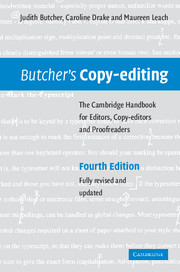Book contents
- Frontmatter
- Contents
- List of illustrations
- Preface to the fourth edition
- Preface to the third edition
- Preface to the second edition
- Preface to the first edition
- Acknowledgements
- 1 Introduction
- 2 Preliminary copy-editing, design and specimen pages
- 3 Preparing the text for the typesetter
- 4 Illustrations
- 5 Proofs
- 6 House style
- 7 Preliminary pages
- 8 Indexes
- 9 Other parts of a book
- 10 Bibliographical references
- 11 Literary material
- 12 Multi-author and multi-volume works
- 13 Science and mathematics books
- 14 Other special subjects
- 15 Reprints and new editions
- 16 On-screen editing
- Appendixes
- Glossary
- Select bibliography and other resources
- Index
13 - Science and mathematics books
Published online by Cambridge University Press: 05 August 2012
- Frontmatter
- Contents
- List of illustrations
- Preface to the fourth edition
- Preface to the third edition
- Preface to the second edition
- Preface to the first edition
- Acknowledgements
- 1 Introduction
- 2 Preliminary copy-editing, design and specimen pages
- 3 Preparing the text for the typesetter
- 4 Illustrations
- 5 Proofs
- 6 House style
- 7 Preliminary pages
- 8 Indexes
- 9 Other parts of a book
- 10 Bibliographical references
- 11 Literary material
- 12 Multi-author and multi-volume works
- 13 Science and mathematics books
- 14 Other special subjects
- 15 Reprints and new editions
- 16 On-screen editing
- Appendixes
- Glossary
- Select bibliography and other resources
- Index
Summary
The complicated notations used by scientists and mathematicians pose special problems and so require more than usually detailed marking up by the copy-editor, even for typesetters who specialize in this kind of setting. This chapter attempts to give some working principles for the choice of nomenclature and its clarification for the typesetter. The books listed on pp. 347–9 are all valuable for reference. For the physical sciences at least, the summary of standard notation in reference (1) is very useful, and pp. 23–49 of (2) will be helpful in the biological sciences and medicine. A list of the more common mathematical symbols and their descriptions is given in appendix 8. Many journals issue instructions or recommendations to authors, which can be a source of information for specialized books.
The widespread adoption of TeX and LaTeX as the typesetting tools of choice in the mathematical and physical science communities since the previous edition of this book was published in 1992 has involved many authors themselves in the typesetting of their manuscripts, often supplying electronic files that require little or no intervention by a professional typesetter in order to produce the first proof. This development carries much potential to simplify the copy-editor's job when dealing with complex mathematical or scientific notation. When used correctly, LaTeX controls much of the formatting and presentation of mathematical material so that the copy-editor need spend less time concerned with, say, the detailed mark-up of individual characters or spacing in equations.
Information
- Type
- Chapter
- Information
- Butcher's Copy-editingThe Cambridge Handbook for Editors, Copy-editors and Proofreaders, pp. 307 - 349Publisher: Cambridge University PressPrint publication year: 2006
